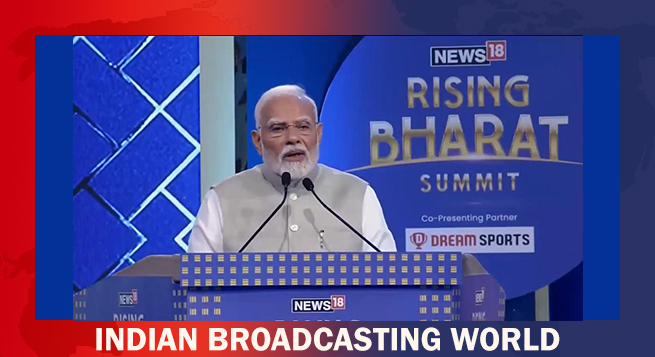There has been a data usage explosion in recent times to 14.1 GB/month/subscriber in Q1 FY2022 from just 1.24 GB per month in Q1 FY18, India’s Economic Survey on Monday said, adding rise in telecom services highlights the opportunity seized by the telcos to build infrastructure, which would be fundamental to the country’s growth
The survey, which can also be termed the annual economic report card ahead of presentation of the country’s Budget, said a case in point of the impressive growth of telecoms services is the rise in the number of mobile towers to 693,000 across the country.
The telecom sector reforms are poised to boost 4G proliferation, infuse liquidity and create an enabling environment for investment into 5G networks, according to Economic Survey 2021-22, PTI reported from New Delhi.
In the wake of “outstanding performance” of the telecom sector in meeting COVID-19 challenges and with a huge surge in data consumption due to online education and work from home, the reform measures will bolster proliferation and penetration of broadband and telecom connectivity, said the Economic Survey tabled in Parliament on Monday.
In addition to telecom infrastructure expansion, a slew of measures have been taken to bring about reforms, the survey said, outlining the structural and procedural reforms undertaken in the Indian telecom sector that represents the world’s second-largest telecommunication market.
“The reforms are also expected to boost 4G proliferation, infuse liquidity and create an enabling environment for investment in 5G networks,” it added.
A strong and responsive regulatory framework has kept service access at reasonable prices, with the government taking further measures to ensure fair competition among service providers with the view to benefit the consumers.
Telecom is among the most powerful sectors impacting the social and economic development of a country, the survey said, observing that the relevance of the sector has “increased immensely”.
The same is reflected in key metrics, such as growth in total telephone subscriber base, steady increase in Internet subscribers, and broadband connections.
In the last few years, the telecom sector in India has become data-driven following reducing costs of data due to the fierce competition in the sector. This has boosted data usage further.
The number of mobile towers has risen substantially to reach levels of 693,000 towers in December 2021, “reflecting that the telecom operators have well realised the potential in the sector and seized the opportunity to build up an infrastructure that will be fundamental in boosting the government’s Digital India campaign”.
Listing out the progress on the connectivity front, the survey said that under the flagship BharatNet broadband project, 546,000 km optical fibre cable has been laid, a total of 173,000 Gram Panchayats (GP) or village administrations have been connected by optical fiber cable (OFC) and 159,000 GPs are service-ready on OFC, as of September 27, 2021.
A boost to the telecom infrastructure is also being given under the aspirational district scheme, while thrust on the provision of submarine optical fibre cable infrastructure will spur high-speed internet and broadband connectivity.
Broadband’s Proliferation:Internet penetration in the country is increasing steadily with internet subscribers increasing from 302.33 million in March 2015 to 833.71 million in June 2021, the survey stated.
While 67.2 percent of the Internet subscribers had narrowband connections and 32.8 percent had broadband connections in 2015, the composition had “reversed by June 2021 with only 4 percent of subscribers having narrowband and 96 percent with broadband connections”.
“Over the last few years, telecom sector in India has become data driven and reducing costs of data due to the fierce competition in the sector. This has boosted data usage even further.
“Total volume of wireless data usage increased by more than 7 folds from 4,206 petabyte in Q1 FY18 to 32,397 petabytes in Q1 FY22. Average wireless data usage in gigabyte(s) per data user per month has also increased tremendously from just 1.24 GB per month in Q1 FY18 to a whopping 14.1 GB per month in Q1 FY22, “ the survey noted.
 AIDCF team discusses industry issues with Vaishnaw
AIDCF team discusses industry issues with Vaishnaw  PM Modi: WAVES will empower Indian content creators go global
PM Modi: WAVES will empower Indian content creators go global  Meta rolls out ‘Teen Accounts’ feature to FB, Messenger
Meta rolls out ‘Teen Accounts’ feature to FB, Messenger  Govt. says pvt. sector TV channels can ride pubcaster’s WAVES
Govt. says pvt. sector TV channels can ride pubcaster’s WAVES  China curbs Hollywood films’ imports in US tariff war
China curbs Hollywood films’ imports in US tariff war  ‘Chhaava’ set to stream on Netflix from today
‘Chhaava’ set to stream on Netflix from today  ‘Bhool Chuk Maaf’ trailer released
‘Bhool Chuk Maaf’ trailer released  ‘The Angry Birds Movie 3’ to release Jan 2027
‘The Angry Birds Movie 3’ to release Jan 2027  TV9 Marathi first Marathi news channel on DD FreeDish
TV9 Marathi first Marathi news channel on DD FreeDish 








